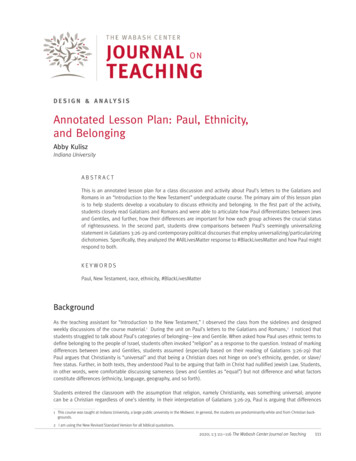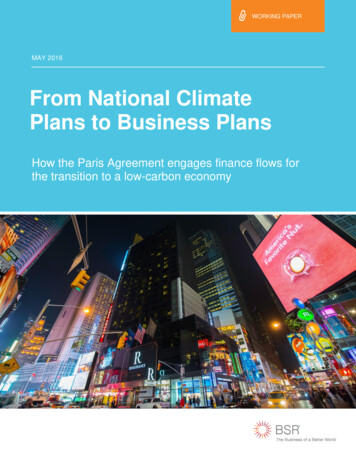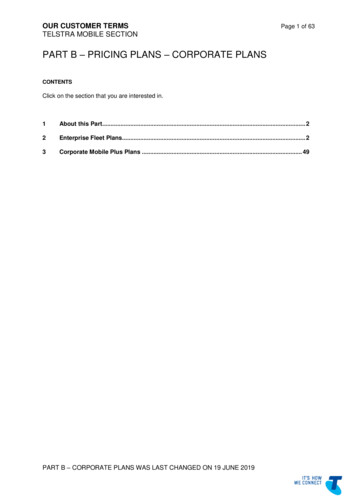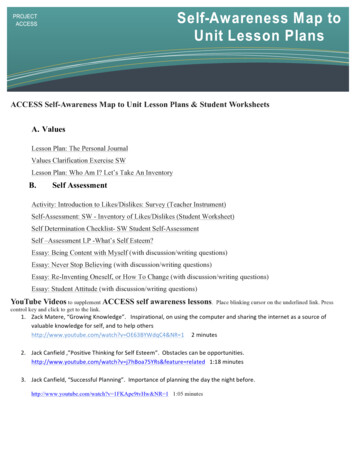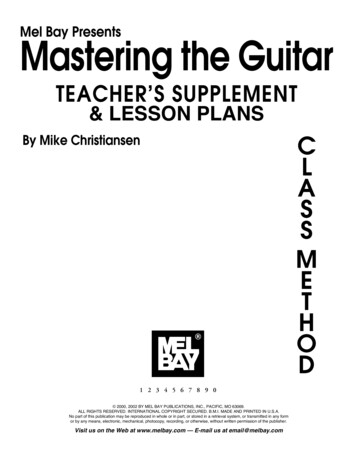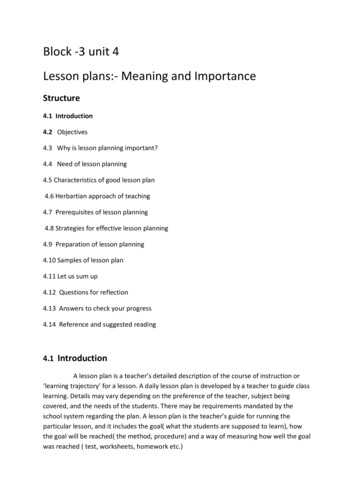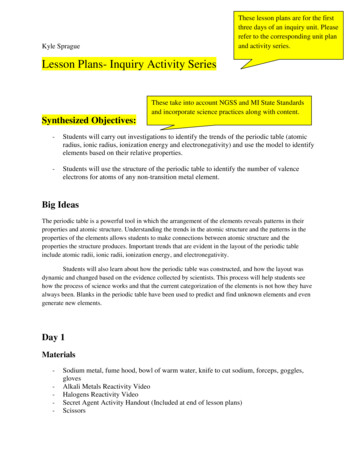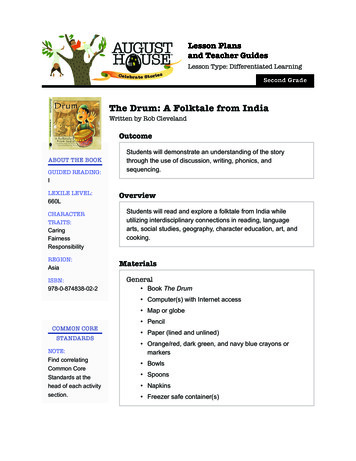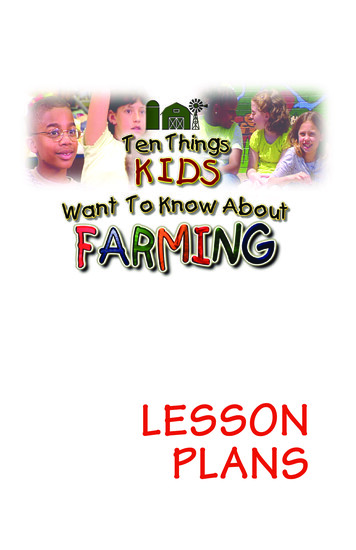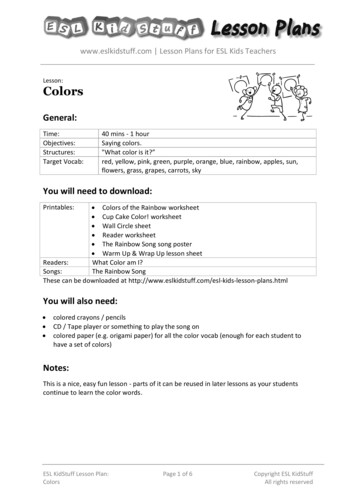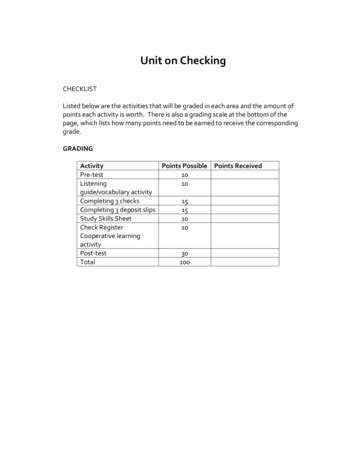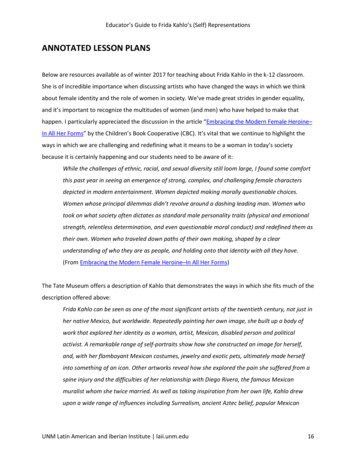
Transcription
Educator’s Guide to Frida Kahlo’s (Self) RepresentationsANNOTATED LESSON PLANSBelow are resources available as of winter 2017 for teaching about Frida Kahlo in the k-12 classroom.She is of incredible importance when discussing artists who have changed the ways in which we thinkabout female identity and the role of women in society. We’ve made great strides in gender equality,and it’s important to recognize the multitudes of women (and men) who have helped to make thathappen. I particularly appreciated the discussion in the article “Embracing the Modern Female Heroine–In All Her Forms” by the Children’s Book Cooperative (CBC). It’s vital that we continue to highlight theways in which we are challenging and redefining what it means to be a woman in today’s societybecause it is certainly happening and our students need to be aware of it:While the challenges of ethnic, racial, and sexual diversity still loom large, I found some comfortthis past year in seeing an emergence of strong, complex, and challenging female charactersdepicted in modern entertainment. Women depicted making morally questionable choices.Women whose principal dilemmas didn’t revolve around a dashing leading man. Women whotook on what society often dictates as standard male personality traits (physical and emotionalstrength, relentless determination, and even questionable moral conduct) and redefined them astheir own. Women who traveled down paths of their own making, shaped by a clearunderstanding of who they are as people, and holding onto that identity with all they have.(From Embracing the Modern Female Heroine–In All Her Forms)The Tate Museum offers a description of Kahlo that demonstrates the ways in which she fits much of thedescription offered above:Frida Kahlo can be seen as one of the most significant artists of the twentieth century, not just inher native Mexico, but worldwide. Repeatedly painting her own image, she built up a body ofwork that explored her identity as a woman, artist, Mexican, disabled person and politicalactivist. A remarkable range of self-portraits show how she constructed an image for herself,and, with her flamboyant Mexican costumes, jewelry and exotic pets, ultimately made herselfinto something of an icon. Other artworks reveal how she explored the pain she suffered from aspine injury and the difficulties of her relationship with Diego Rivera, the famous Mexicanmuralist whom she twice married. As well as taking inspiration from her own life, Kahlo drewupon a wide range of influences including Surrealism, ancient Aztec belief, popular MexicanUNM Latin American and Iberian Institute laii.unm.edu16
Educator’s Guide to Frida Kahlo’s (Self) Representationsfolklore, eastern philosophy and medical imagery. (From the Tate Museum: Introduction to FridaKahlo)Following the lesson plans listed below, you’ll find an annotated bibliography of children’s, young adult,and adult literature about Kahlo. With so many excellent books on Kahlo, it is easy to mix and match thelesson plans shared here with a literacy unit on historical fiction or biography. The complementarymultimedia, audio, and visual resources could further enhance a unit focused on Kahlo.Frida Kahlo: Information and Activity Pack for Teachers created by Tate Modern MuseumThrough their unit plan students explore pairs of works that are studied and analyzed as theyrelate to specific themes, such as “Belief Systems and Links with Nature,” ConstructingIdentities,” “Relationships, Politics and Constructing Identities,” “National Identities,” and “TheBroken Body, Illness, Disability.” For each theme there is an activity created for primary andsecondary classes. To give you a sense of what you’ll find throughout the guide, for one theme,primary students learn how to make mood masks, while secondary students look at bodylanguage and clothing through keeping a sketch book journal.Frida Kahlo and The Art of Self-Portraiture from the Teacher’s NetworkThis unit was created by Jessica Rivera and is based on lesson plans implemented with thirdgrade students. While teaching about Kahlo, the unit also covers a number of technological andacademic subject objectives. Students will be exposed to skills and rules for using the internet,along with practice in using other technology tools such as scanners and/or digital cameras.Students will also learn how to create a virtual museum. Reading and writing across genres isalso incorporated into the unit.Frida Kahlo: A Portrait of a Woman in Art from the Kimball Art CenterThis lesson plan focuses entirely on teaching students how to draw a self-portrait within thecontext of teaching about Kahlo. It is a simple and straightforward unit plan that can be easilyadapted for a variety of grade levels. Although no longer available directly through the KimballArt Center, the lesson plan can be accessed as a Word document from the LAII’s Vamos a Leerblog.UNM Latin American and Iberian Institute laii.unm.edu17
Educator’s Guide to Frida Kahlo’s (Self) RepresentationsThe Life and Times of Frida Kahlo: Personal or Political? from PBSThis lesson plan draws upon the PBS documentary of the same name, which offers an intimatebiography of a woman who gracefully balanced a private life of illness and pain against a publicpersona that was flamboyant, irreverent, and world-renowned. Kahlo was an eyewitness to aunique pairing of revolution and renaissance that defined the times in which she lived. In thislesson plan, students will consider what makes art political, debate the relevance of the term"political art" to Frida Kahlo’s work, and create their own self-portraits using the style of FridaKahlo as inspiration.Frida Kahlo and Expression through Self-Portraits from ScholasticStudents learn about the Mexican painter, and then create self-portraits while considering thequestion, "What is important to you?"Studying the Biographies of Frida Kahlo and Diego Rivera from Yale National InitiativeThe purpose of this unit is to introduce students to the genre of non-fiction, specifically focusingon biographies. This unit will introduce biographies by reading brief biographies of Frida Kahloand Diego Rivera. Students will two short biographies of Kahlo and compare how the storiesvary from author to author. By the end of the unit they will be very familiar with the lives ofFrida Kahlo and Diego Rivera. They will have read, analyzed and compared biographies bydifferent authors. They will also be given brief biographies of various people to read andparaphrase. Finally students will create an autobiography booklet of themselves.Understanding Frida in Context through her Still Life: Pitahayas by MMOCAThis short lesson plan focuses on Frida’s still life painting, Pitahayas, as a way to delve moredeeply into understanding her and her work. Each object in Still Life: Pitahayas tells ussomething about Frida Kahlo: where she lived, her interest in her native Mexican culture, herphysical pain, and her attitudes toward life and death.Frida Kahlo and the Symbolic Self Portrait by the Albright-Knox Art GalleryFrida Kahlo was largely known for her symbolic self-portraits reflecting her life, loves, joys, andsorrows. Influenced by her Mexican culture, she uses vibrant color and meaningful imagery toUNM Latin American and Iberian Institute laii.unm.edu18
Educator’s Guide to Frida Kahlo’s (Self) Representationsportray her self-identity to the viewer. In this lesson, students will make connections to theartist while creating a self-portrait celebrating their own self-identity.Frida Kahlo as a Biographical StudySuggestion: Use biographical studies as a jumping off point to explore Frida Kahlo and her art.The Art Story has created a relatively thorough yet accessible biographical summary of Frida’slife, including a useful, annotated compilation of her images. As you shape this exercise, youmight consider this brief introduction to “Why Teach with Biographies?” as well as this articlefrom the NYTimes on “Children’s Books: Putting Life into Biography.” This could help frame howto approach the unit. Then, use one of the following lesson plan modules as a starting point toconceptualize the best activity to fit your classroom needs: “Introducing the Biography Genre”from Scholastic; “Writers’ Workshop: The Biographical Sketch” from ReadWriteThink; or“Exploring Elements of Biography and Autobiography” from the Pennsylvania Department ofEducation.Frida and the Art of the SelfieSuggestion: It might be an interesting exercise to connect Kahlo’s practice of creatingautorretratos with the art of digital selfies. Teacher Kristy Placido has written a unit on“Incorporating Selfies and Self Portraits with Frida” that takes students through the art of takinga selfie as inspired by Frida, using digital imagery and mixed media materials. To further deepenthe connection between autorretratos and selfies, we suggest reading this article by the NewStatesman on “What Frida Kahlo Can Teach Us About the Art of the Selfie.”Politics and the Self: Self-Portraiture and “Where I’m From” PoetrySuggestion: One means of encouraging students to think deeply about Kahlo’s biographical andpolitical context is to ask students to engage in a combined art and literary exercise. Begin byhaving students craft a “Where I’m From Poem” (lesson plan available on the LAII’s Vamos aLeer blog). Then, after examining a variety of Kahlo’s self-portraits, ask students to create a selfportrait that incorporates elements of their own biographical history or political values. Art isBasic has a “Mixed Media Self-Portraits” lesson plan that could be easily adapted for this.UNM Latin American and Iberian Institute laii.unm.edu19
Educator’s Guide to Frida Kahlo’s (Self) RepresentationsBuilding Self Affirmation: Soy Yo and “Where I’m From”Suggest: To explore Kahlo’s strong sense of self and self-affirmation, you might considercombining art and music. Once again use the “Where I’m From Poem” lesson, but complementit with the song Soy Yo by Bomba Estereo, a piece whose lyrics and music video both, as NPRwrites, “pays tribute to what’s inside of you.”Examining Frida Kahlo through Visual Literacy StrategiesSuggestions: Apart from self-portraiture and biographical studies, another method of bringing FridaKahlo into the classroom would focus on visual literacy strategies, or strategies that help studentscritically interpret and negotiate the meaning of visual content. The following resources are not specificto Kahlo’s work, but offer useful frameworks for guiding classroom discussions focused on visualliteracy.Visible Thinking Pictures of Practice by Visible ThinkingThis web resource offers a number of visual thinking strategies to encourage students’independent reflection and critical thinking skills. Stephanie Martin created the Thinking Keysroutine with a colleague as a way to help students reflect on their own thinking. The four keysand associated questions give children the vocabulary necessary to think about and discuss theirthinking. The four keys are: Form: What is it like?, Function: How does it work?, Connection:How is this like something I have seen before? and Reflection: How do you know?Common Core in Action: 10 Visual Literacy Strategies by EdutopiaEdutopia has compiled a list of ten different approaches for building visual literacy skills andthen tied them to Common Core Standards.Practice Looking at Art from The Museum of Fine Arts, HoustonEngaging with a work of art is a meaningful and lasting experience. The following four-stepprocess, designed by Museum staff, encourage close looking and careful thinking with any workof art that you view with your students, either in your classroom or in the Museum.UNM Latin American and Iberian Institute laii.unm.edu20
ANNOTATED LESSON PLANS Below are resources available as of winter 2017 for teaching about Frida Kahlo in the k-12 classroom. She is of incredible importance when discussing artists who have changed the ways in which we think about female identity and the role of women in society. Weve made great strides in gender equality,

